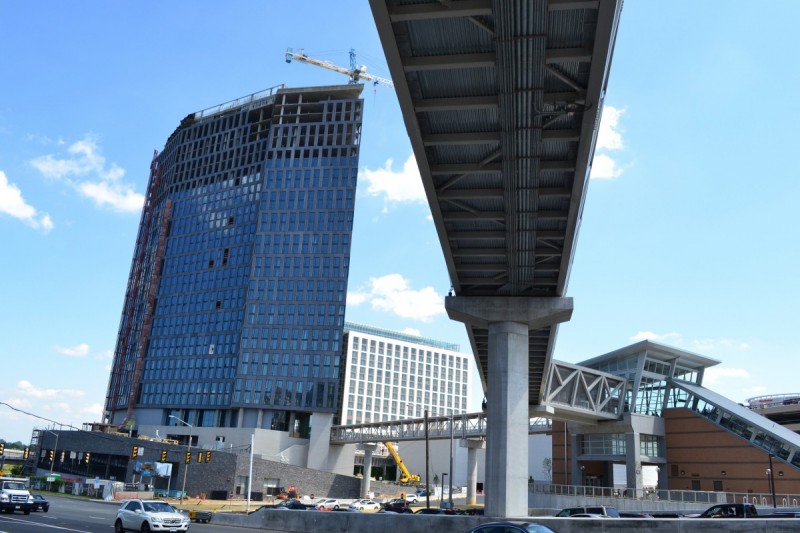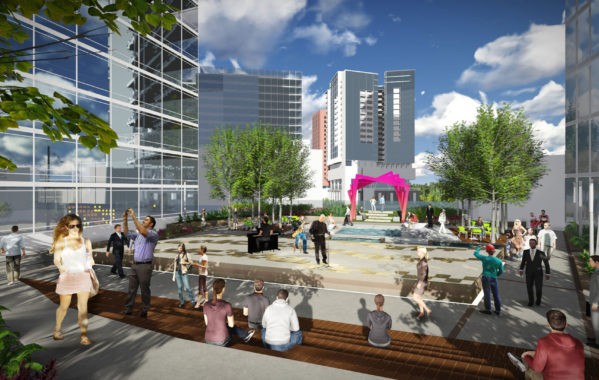Tysons Corner wants people to live on the edge

Tysons Corner Center mall. Image by Malcolm K. licensed under Creative Commons.
There are big changes afoot in Tysons Corner, a flashy “edge” city where many people go to work, eat, and shop — but rarely live. Tysons’ vision for 2050 is to build transit-oriented development, a mix of density, and walkable spaces in an effort to attract new residents.
An edge city is an American trend where businesses, retail, and entertainment are located on the periphery of a larger city, in this case Washington, DC. Edge cities like Tysons already have foot traffic and transient occupants — the job is to make them stay.
Living on the edge
Like beads in a necklace, European cities have traditionally formed from urban nuclei in rural areas. As the population grows, these nuclei gradually expand in a regulated fashion to become larger entities, eventually connecting with one another and fostering dense, mixed-use urban neighborhoods.
In contrast, American cities are surrounded by long stretches of suburban landscapes, a sprawling growth pattern that reflects a “settling outside of the city” mentality. American movies play a major role in propagating this ideal, and expats (including myself) think settling in the suburbs is the ultimate American dream. After living in the States for a year, I know it’s evolving.
Today, many American cities are growing similarly to how European cities traditionally have. It won’t be long before European and American urban patterns acquire a certain resemblance — not quite like twins, but more like siblings. One way this trend is manifesting is through edge cities like Tysons Corner, which is gradually turning into a mixed-use urban setting.
Tysons from the air. Image by Brian Allen used with permission.
Regardless of one’s nurture, nature, or living preferences, most people want easy access to amenities like grocery stores and shops, as well as recreational space like parks. Millennials especially want live differently from their parents — they’re not as interested in buying a house in the suburbs with a lawn and white picket fence and a long drive to get milk when it runs out.
So how does the market create a product that appeals to younger Americans who aren’t as interested in living in edge cities and suburbs? It converts existing suburbs and edge cities into urban spaces where millennials want to be.
This may just seem like good business strategy, but it’s more than that. This shift is exciting for urbanists and other environmentally-minded people because the demand for dense neighborhoods aligns with sustainability and “smarter growth” goals.
Edge cities like Tysons are trying to grow smarter
Located in Fairfax County along the Silver Line, Tysons grew out of a rural farming community that had settled there in the 50s. A decade later, a different type of development followed the construction of the Beltway, Dulles Airport, and a shopping mall. By the end of the 80s, the area had converted into a business and retail hub: in other words, an edge city.
Once the Comprehensive Plan Amendment was finished in 2010, only 19,627 people lived there. Tysons was mostly composed of office, retail, and headquarter buildings. After the Silver Line was completed in 2014, an influx of people came to patronize the unincorporated community’s two shopping malls: Tysons Corner Center and Tysons Galleria.
Inside the Tysons Galleria mall. Image by Famartin licensed under Creative Commons.
Following Tysons’ amendment and rezoning, the area is being redeveloped, unused space is being filled, and it’s becoming walkable and accessible.
Tysons is using its Silver Line access to create a walkable, green urban center that includes public space and parks, public transportation infrastructure, bike paths and sidewalks, and circulating bus and van routes. It has 45 million square feet of new construction, including 100,000 square feet of residential space.
Tysons wants you to stay awhile
To get a better sense of how this smart growth phenomenon is manifesting in Tysons, I talked to some people involved in the Dominion Square (CARS) development, which spreads over 4.4 million square feet in the city center near the Spring Hill Metro station. It includes a mix of densities and transit-oriented development, with a focus on sustainable practices.
Photo from the Tysons CARS Development event. Image by Tysons Partnership used with permission.
VIKA Virginia Principal Bob Cochran, who is planning the transportation aspect of CARS, says when it comes to creating livable communities, “the whole is greater than the parts.” He says this project is not a one-off initiative, and that Tysons will continue to promote multi-functional, mixed-use strategies with developers in the future.
Plans for Dominion Square CARS, courtesy of LandDesign. 
Plans for Dominion Square CARS, courtesy of LandDesign. 
There are 2 million square feet of residential space slated for the area, including 1,300 housing units in the lot between CARS West and CARS East. There will also be 2 million square feet of office space, as well as hotels and retail.
Plans for Dominion Square CARS, courtesy of LandDesign. 
Plans include places for people to congregate like public parks, urban plazas and skyparks, while the street grid design promotes community connectivity. The regenerative design is “filling in the blanks” in an already developed urban center with existing infrastructure. That’s a shift from Tysons’ historic pattern of building out onto non-urban land.
The goal is to “make this a true urban experience as opposed to leftover urban space,” says Stephanie Pankiewicz, partner at LandDesign, the landscape architects for the project.
The Tysons Partnership’s people-oriented strategy aims to redefine the area from singular commercial use to a multi-functional one where people want to live. Time will tell if it will be successful, but Tysons seems to be evolving from edge city to a city in its own right.
